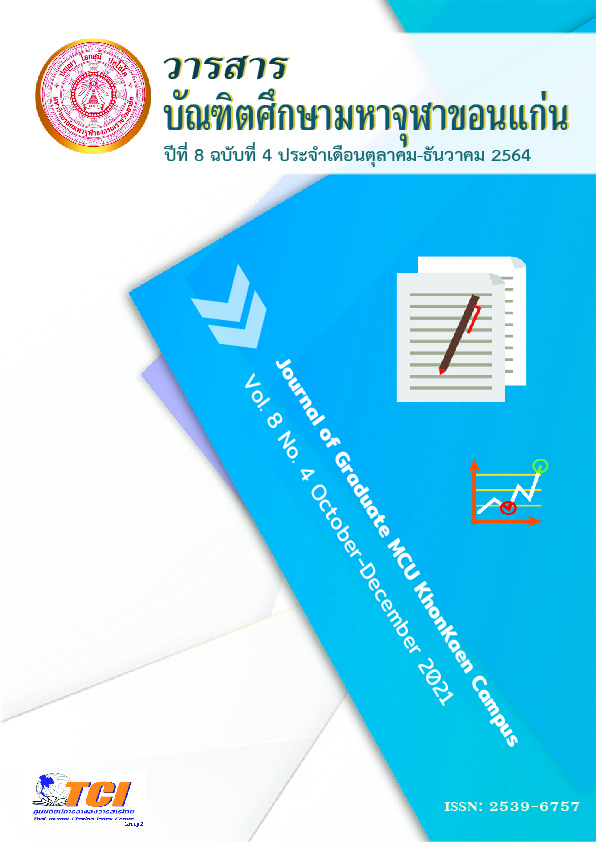THE ETHICAL ANALYSIS IN RAMAYANA LITERATURE
Main Article Content
Abstract
The objectives of this research were: 1) to study ethical theory and concepts; 2) to study Ramayana literature and 3) to analytically study ethical principles in Ramayana literature. This study was carried out by means of documentary research through studying the information from the Tipitaka, academic papers and related research.
The gathered data were analyzed by inductive descriptive method.
The research results were as follows:
1. Ethical concepts and theories are a practice to bring happiness and prosperity to oneself and society. It is a concept that discusses the truth and the events that occur according to the principle of cause and effect that prove the facts. Ethics is characterized as a guide to the course of action leading to the highest position of life.
2. The origin of Ramayana, King Buddha Yodfa Chulalok the Great's version, which is detailed from Ramayana, Rishi Valmiki's edition, which is brought together to become the Ramayana of Thailand. Its content is modified in accordance with the culture of each country until it becomes a national literature such as Thailand, Laos, Myanmar, Cambodia, Malaysia and Indonesia, etc.
3. The analysis of ethics in Ramayana literature: for religious ethical practices, Ramayana is a religious literature written to convey knowledge and understanding to the readers to see the differences between the characters of two sides in the story: good side and the bad side. The ethics are 1) the principles of ethics towards society in terms of governance, including Ten Duties of the King, Four Sublime States of Mind, Twelve Duties of a Universal King, Unity, Four Bases of Social Solidarity; 2) ethical principles to wards family including Five Precepts, Honesty; 3) ethical principles to oneself including Four Paths of Accomplishment.
Article Details
References
กรุณา-เรืองอุไร กุศลาสัย. (2537). ภารตวิทยา. กรุงเทพมหานคร: สำนักพิมพ์ศยาม.
ทวีศักดิ์ ญาณประทีป. 2548. วรรณกรรมศาสนา. (พิมพ์ครั้งที่ 5). กรุงเทพมหานคร: สำนักพิมพ์รามคำแหง.
รัตนา คชนาท. (2547). รามเกียรติ์ ปฐมบทจุดกำเนิดแห่งสงคราม ความรักและความคับแค้น.กรุงเทพมหานคร: สำนักพิมพ์ ห้องเรียน บจก.
สมพร สิงโต. (2517). ความสัมพันธ์ระหว่างรามายณะของวาลมีกิและรามเกียรติ์พระราชนิพนธ์ในรัชกาลที่1. ใน วิทยานิพนธ์อักษรศาสตรมหาบัณฑิต. บัณฑิตวิทยาลัย: จุฬาลงกรณ์มหาวิทยาลัย.
อธิษฐ์ ทองอินทร์ และ ภานุพงศ์ยิ้มณรงค์. (2558). การศึกษาวิเคราะห์คุณธรรมด้านการปกครองในบทละครเรื่องรามเกียรติ์ พระราชนิพนธ์ในพระบาทสมเด็จพระพุทธยอดฟ้าจุฬาโลกมหาราช: กรณีศึกษาด้านสังคหวัตถุ 4. การประชุมวิชาการระดับชาติครั้งที่ 2. สถาบันและพัฒนา มหาวิทยาลัยราชภัฏกำแพงเพชร.
เอกฉัทร จารุเมธีชน. (2545). ลักษณะวรรณคดีสันสกฤตยุคพระเวท. (พิมพ์ครั้งที่ 3). ขอนแก่น: โรงพิมพ์พระธรรมขันต์.
Ramakian Home. (2562). รามเกียรติ์. สืบค้นเมื่อ 23 กรกฎาคม 2564, จาก http://www. Ramakian.Cjb.net.
